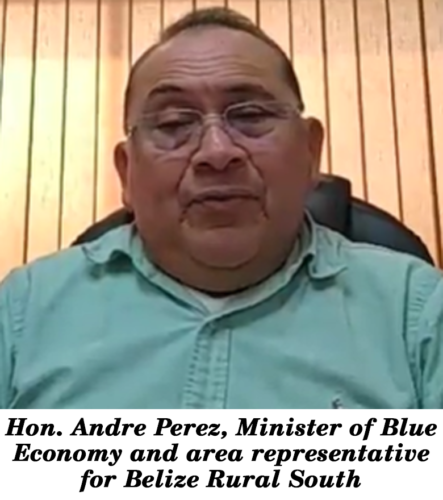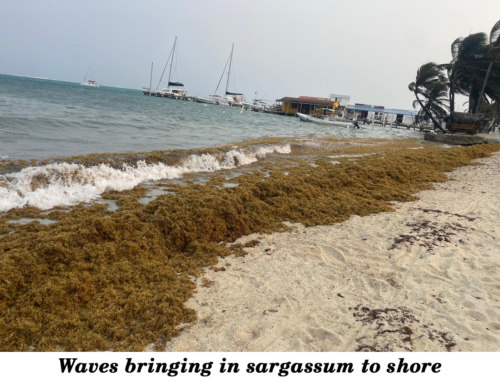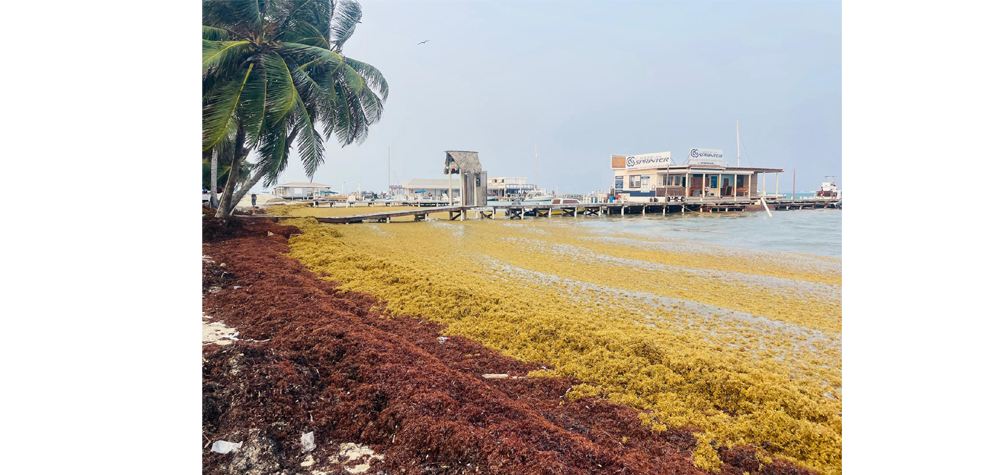Photo: Sargassum surrounding shorelines in San Pedro
by Kristen Ku
SAN PEDRO TOWN, Ambergris Caye, Thurs. May 16, 2024
In addition to the extreme heat, forest fires, and haze plaguing our country over the past few days, another challenging natural phenomenon, found near Belize’s coastal regions, is the influx of sargassum.
This year, the arrival of the large masses of brown seaweed has been more overwhelming than ever, posing significant threats to the environment and the tourism industry.
“It’s coming, we believe, this year with a vengeance. And we have been warned. We have been warned. Last year, it was pretty much stable; but this year, by all accounts, it’s coming with a vengeance,” said Hon. Andre Perez, Minister of Blue Economy and area representative for Belize Rural South.

In reality, sargassum, which is typically seen between April and October, can provide important ecological benefits in moderate amounts. It serves as a nursery for various marine species, and contributes to the ocean’s nutrient cycle. However, when it accumulates excessively, it becomes a severe nuisance.
The seaweed covers entire beaches, emits an unpleasant odor when decomposing, and disrupts the natural beauty of coastal areas. A recent video released online reveals just how frustrating sargassum accumulation could be, as it surrounded an entire pier and shoreline. Workers nearby were seen working to scoop up as much as they could for disposal; however, their efforts seemed futile, as more sargassum just kept floating in with each wave.

According to Minister Perez, the sargassum problem is closely linked to, and driven by, climate change, which is no longer a distant threat but a present reality, manifesting through extreme weather conditions, forest fires, and the influx of sargassum.
“It’s time for us to understand and sensitize the entire country and the region … the changes that are occurring in our country, in our atmosphere, in our community, is because it’s all related to climate change. If you think it’s not about to happen, it is already happening,” he said.
For seaside tourist resorts, the sargassum invasion represents a serious threat, as the accumulation of sargassum on the shores not only detracts from the natural beauty of the beaches but also emits a strong, unpleasant odor that can drive tourists away.
In response to the escalating crisis, Belize has been exploring various mitigation strategies. Recently, the country acquired two specialized skimmers, or harvesters, designed to capture sargassum at sea before it reaches the beaches.
These skimmers, equipped with advanced machinery, can collect the seaweed from the water and transport it to a smaller barge. This method aims to seize the sargassum at sea, particularly at the breaks in the reef, preventing it from spreading along the coast.
The skimmers, imported from China, have undergone successful test runs and are expected to be fully operational within the next few weeks. While the initiative is costly, with the skimmers costing nearly a million dollars, Minister Perez is hopeful that it will provide an effective solution to the sargassum influx.
The use of drones and other modern technologies to monitor the flow of sargassum and its accumulation points has also been noted as an element of the mitigation strategy. By studying the movement of sargassum from a vantage point above the sea, the Ministry aims to identify and manage its arrival, and improve the deployment of skimmers to capture the seaweed before it reaches the shore.
Notably, the pilot project is a collaboration between the Ministry of Blue Economy and the Ministry of Tourism, and will be overseen by the Hol Chan Marine Reserve.

